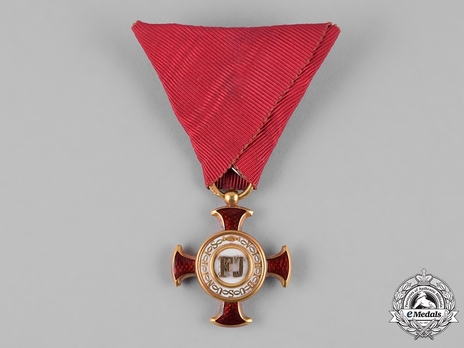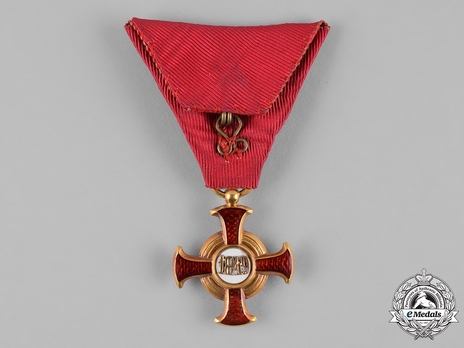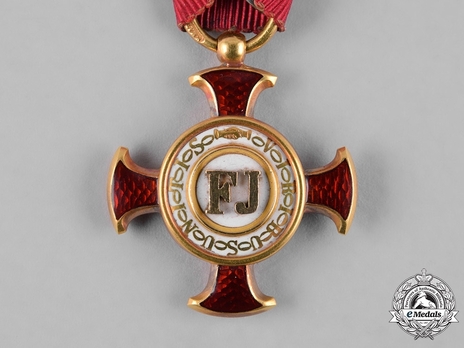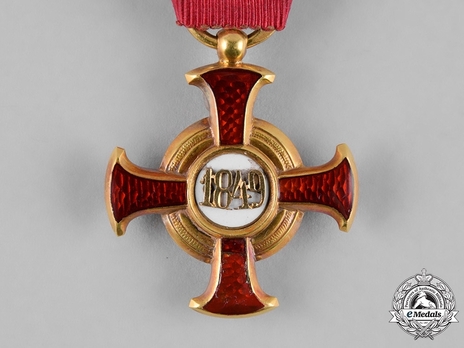Merit Cross "1849", Type II, II Class Cross
CATEGORY: Version
SKU: 02.AUT.0108.102.01.000
Estimated market value:




Estimated market value:
Austria, Imperial. A Cross of Merit in Gold with Case, by V. Mayers Söhne, ca. 1908
(Goldenes Verdienstkreuz mit Etui). Instituted 16 February 1850. (1850-1918 issue). Constructed of 18 kt. Gold with multi-coloured enamels, consisting of a Ruppert Cross with red enameled arms and a Gold frame, the obverse with a central white enameled medallion bearing a central Gold monogram of Franz Joseph I, circumscribed by an inscription of “VIRIBUS UNITIS” (“UNITED FORCES”), the reverse with a central white enameled medallion bearing a Gold date of “1849”, on a gilded and enameled crown suspension with loop connecting to a period original tri-fold ribbon, the loop maker marked “V. MAYERS SÖHNE, WIEN” with a gold assay mark and letter “A” indicating Vienna manufacture, measuring 29.43 mm (w) x 33.69 mm (h), weighing 11.5, accompanied by its period original presentation case, constructed of heavy card stock with a faux black leather exterior, the obverse lid with a gold embossed inscription of “V.K.”, the interior with a white satin lid liner with a maker’s mark of “V MAYERS SÖHNE, K.u.K. HOF U. KAMMERJUWELIERE ORDENFABRIKANTEN, WIEN”, with a slotted and depressed dark green velvet medal bed, opening with a functional metal spring catch with exterior stud release and a functional magnetic metal hinge, measuring 58 mm (w) x 92 mm (l) x 18 mm (h), in extremely fine condition.
The Imperial Decree of February 16, 1850 announced the creation of the new Cross of Merit to replace the Civil Medals of Honour. This was awarded primarily to civilian achievements. More specifically it was “to reward loyal and actively reliable devotion to Kaiser and Fatherland, long years of fruitful employment in public service or other achievements for the general good.”
The Cross of Merit was originally awarded in four classes, as a ‘gold’ and a ‘silver’ cross each with or without a crown. Multiple awards could be conferred upon the same recipient, and lower levels could still be worn after a higher one was awarded. Women could also be awarded the Cross of Merit, prior to the outbreak of the war.
In September 1914, the Statutes were amended to include soldiers who were away from the front. However, these decorations would be worn on the red and white silk ribbon of the bravery medal. As of February 1916, ‘gold’ crosses were constructed of bronze due to the lack of material during the war.
On April 1, 1916, the “Iron Cross of Merit” was created. It was only to be awarded during the war and only to NCOs. This decoration looked like the gold and silver crosses but used rust-protected iron and was not enamelled. The reverse presents the year 1916. It was awarded to all other ranks and NCOs not in a rank group who were born in 1865 and 1866, who in 1917 were still actively participating in the war were automatically awarded the Iron Cross of Merit. Anyone who had already received this award was provided with a silver bar for the ribbon. In 1918, this provision included the men born in 1867. As the war progressed the composition changed from rust-protected iron to pewter or zinc alloys.
In December 1916, the Decoration could include swords, which indicated achievement in the face of the enemy or in effective leadership of a formation.
In February 1918, it became possible to be awarded the Gold and Silver crosses (with or without crown) more than once, denoted by a gold bar on the ribbon.
The Type I and Type II crosses are worn on red ribbons. The Type II I Class Cross and III Class Cross have a larger surmounting crowns than the awards in Type I. They main manufacturers are Vincent Mayer’s Sohne, Rozet & Fischmeister, Rothe & Neffe.
The inscription VIRIBUS UNITIS translates to “With United Forces.”

Comments
Sign in to comment and reply.


Scroll Top